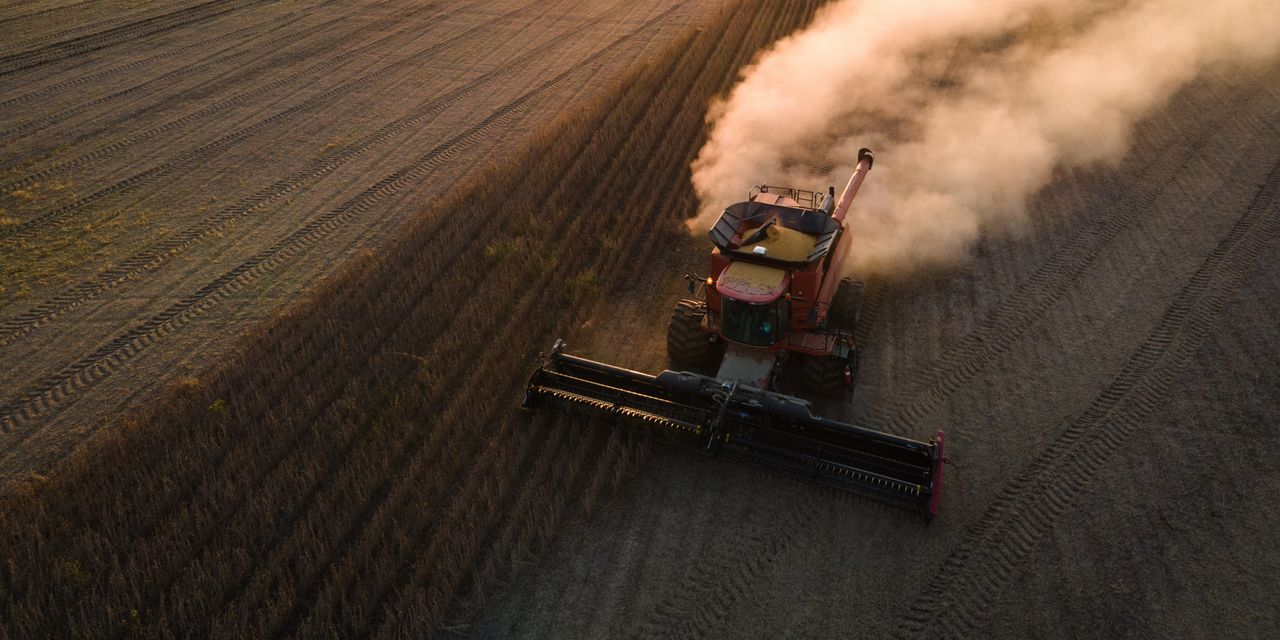

U.S. soybean prices have surged in recent months amid shrinking forecasts for South American crops.
Prices for soybeans—the base ingredient in many food products, poultry and livestock feed and renewable fuel, among other things—are edging back toward highs reached last year, which hadn’t previously been seen in a decade. Abnormally dry weather in South America that has spurred surges in coffee and sugar prices also has affected soybeans there, and U.S. farmers are poised to take advantage by planting more this year.
Soybean futures on the Chicago Board of Trade are trading at their highest level since June, with the most-active contract closing up above $15.80 a bushel on Friday. Soybeans have risen over 18% in the year to date, outpacing prices for corn and wheat, which have climbed in reaction to tensions at the Russia-Ukraine border.
Higher prices for animal feed come as meat producers struggle to meet consumer demand. In its earnings report Monday, Tyson Foods Inc. said that orders for beef, chicken, and pork continue to outpace its ability to supply them, due in part to labor issues at packing plants.
In its latest world supply-and-demand report, released Wednesday, the U.S. Department of Agriculture forecast that Brazilian soybean production will fall 5 million metric tons to 134 million tons, and cut its Argentine outlook by 1.5 million tons to 45 million tons.
Should South American production continue to weaken, prices are expected to sustain their rally—and large soybean importers such as China would be expected to look elsewhere to procure their supplies.
“The pressure is on U.S. farmers to make up the difference,” said Sal Gilbertie, president of Teucrium Trading LLC.
Demand for U.S. grains as a whole already is at records. The USDA said Tuesday that exports of U.S. farm and food products world-wide totaled $177 billion in 2021, 18% higher than 2020 and nearly 15% higher than the previous record set in 2014. Six of the 10 leading export customers purchased a record amount of U.S. grains, the USDA said, with China the leading buyer at $33 billion.
“It’s clear that our international trading partners are responding favorably to a return to certainty from the United States,” Agriculture Secretary
Tom Vilsack
said in a statement Tuesday.
In the last full marketing year, Brazil exported 81.7 million metric tons of soybeans, making it the leading exporter. The U.S. was next, at 61.5 million tons. China was far and away the leading importer at nearly 100 million tons.
With dry weather in South America hurting soybean production there, Brazilian farmers are reluctant to sell their crops to exporters, said
Arlan Suderman,
chief commodities economist with
in a Feb. 4 note. “That has huge implications for the U.S. balance sheet.”
For U.S. farmers, the potential of increased demand from the world export markets comes as higher fertilizer costs are pushing more farmers toward planting soybeans this year. Agricultural research firm Farm Futures last month forecast that planted soybean acreage in the U.S. may exceed corn for the first time since 2018 and only the second time in history.
In its January report, Farm Futures forecast planted acreage of soybeans in the U.S. at 92.4 million acres for 2022, which would be the largest soybean crop on record. Meanwhile, corn acres are expected to drop roughly 3 million acres to 90.4 million acres.
A global shortage of the ingredients needed to make fertilizer, along with a snarled supply chain globally, have sent fertilizer prices skyrocketing in recent months. These prices have largely kept rising, with agricultural research firm DTN this month assessing the anhydrous ammonia fertilizer price at $1,492 a ton—up over 200% from the same time last year and a record.
Corn is fertilizer-intensive, and farmers may opt for planting more soybeans this growing season, which usually begins in late April.
Still, any demand South American supplies are unable to meet comes at a time when U.S. reserves are light. In January, the USDA forecast beginning stocks for U.S. soybeans at 257 million bushels in the 2021-22 marketing year. That is down from 525 million bushels in 2020-21 and 909 million bushels the year before that.
Meanwhile, Chinese officials have indicated interest in building security for their grain supplies, partially by setting aside land to grow more soybeans.
Write to Kirk Maltais at kirk.maltais@wsj.com
Copyright ©2022 Dow Jones & Company, Inc. All Rights Reserved. 87990cbe856818d5eddac44c7b1cdeb8
24World Media does not take any responsibility of the information you see on this page. The content this page contains is from independent third-party content provider. If you have any concerns regarding the content, please free to write us here: contact@24worldmedia.com

Common Mistakes When Using Athletic Field Tarps

High-Performance Diesel Truck Upgrades You Should Consider

Warehouse Optimization Tips To Improve Performance

Fire Hazards in Daily Life: The Most Common Ignition Sources

Yellowstone’s Wolves: A Debate Over Their Role in the Park’s Ecosystem

Earth Day 2024: A Look at 3 Places Adapting Quickly to Fight Climate Change

Millions of Girls in Africa Will Miss HPV Shots After Merck Production Problem

This Lava Tube in Saudi Arabia Has Been a Human Refuge for 7,000 Years

Four Wild Ways to Save the Koala (That Just Might Work)

National Academy Asks Court to Strip Sackler Name From Endowment

Ways Industrial Copper Helps Energy Production

The Ins and Out of Industrial Conveyor Belts